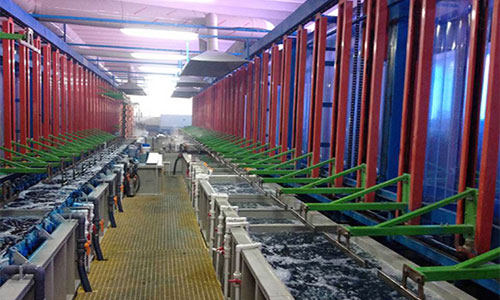How many types of Surface Treatment?
Surface treatment is the process of forming a coating on the surface of a workpiece by a certain method. The purpose is to make the surface of the product beautiful and anti-corrosive. Generally speaking, there are no special requirements for the surface treatment of precision castings. The investment castings can be rust-proof only by applying anti-rust oil. But, to improve the appearance quality, protect the surface from external influences, change material properties and brand influence, etc. We will do a casting surface finishing.

Surface treatment methods can be summarized in the following common methods:
1.Plating Electroplating
Immersion of the electroplated parts in an aqueous solution containing the deposited metal compound. The plating solution is allowed to flow through the plating solution to deposit and deposit on the component. General electroplating includes galvanizing, copper, nickel, chromium, copper-nickel alloy, and the like. Sometimes phosphating is also included.

2. Mechanical plating
The surface of the product is changed by the particles of the coated metal. The coating is cold welded to the surface of the product.
3. Auto-catalytic Plating
It is known as “Chemical Plating”. “Electroless Plating” and other autocatalytic nickel-phosphorus plating and industrial applications. Electroless nickel plating is a surface treatment process that is currently developing at a high speed in the world. It is pollution-free, easy to operate and widely used. The coating has good wear and corrosion resistance.
4. Immersion Plating
A gold-yellow copper-tin alloy layer was prepared on the surface of steel parts by displacement reaction immersion plating using copper sulfate and stannous sulfate as main salts.
By adding a complexing agent of a fluorine-containing anion and a carboxyl anion, the rate of substitution reaction of copper and tin ions is controlled. And an alloy plating layer having a copper content of 1 5% to 39% is obtained. And the appearance is 18 to 2 K gold. The film layer is bonded. Good strength, excellent corrosion resistance.
There are two types of electroless gold-plated ones. One is a chemical reduction type using a reducing agent. And the formed coating is generally auburn or gold with poor color, and the adhesion of the coating is poor. Immersion plating, ie, displacement plating or contact plating. It is a displacement reaction driven by an electromotive force generated by a potential difference between two metals. Do not need an external current or a reducing agent. Low immersion plating equipment, high efficiency, and low cost
5. Chemical Conversion Coating
Chemical Conversion Coating Blackening. Commonly known as “blackening”.Steel Phosphating. Composite plating (dispersion plating) Or the chemical method of using metal ions and the non-solution that is uniformly suspended in the solution
6. Chrome Plating
Chrome plating refers to the act of plating chromium as a plating layer on other metals.
7. Paint Finishing
Including various coatings such as hand coating, electrostatic coating, electrophoretic coating. Can be operated according to sample or color number. Secondly used surface treatment method for castings. Mainly used as the surface treatment for steel castings and iron castings.
8. Hot dip plating
Hot-dip coating is referred to as hot plating. It is a method of immersing a metal plated material in another liquid metal or alloy having a lower melting point for plating. The basic feature of this method is the formation of an alloy layer between the base metal and the plated metal.
9. Hot-dip galvanizing
(Galvanizing), commonly known as “lead water”. Hot-dip galvanizing is the process of coating fabricated steel by immersing the castings in a bath of molten zinc.
This is accomplished by immersing the carbon steel component in a plating bath of molten zinc at a temperature of about 510 °C. The result is that the iron-zinc alloy on the surface of the steel piece gradually becomes passivated zinc on the outer surface of the product.
Hot dip aluminizing is a similar process.
There are three fundamental steps in the hot-dip galvanizing process. They are surface preparation, galvanizing, and inspection

10. Hot-dip tinning (Tinning).
Hot-dip tinning mainly uses the semi-automatic method to continuously remove the dirt and rust spots on the surface of the object to be plated by continuous automatic washing and pickling. Then impregnating the flux to help subsequent plating. The tin solution is immersed after the tin is processed. Then, after a series of steps of spreading, tapping, turning, etc.
The excess tin liquid on the body of the plating body is removed and the tin liquid is evenly laid thereon. After cooling and drying, a pair of workpieces are produced to produce hot dip tin plating.
11. Cathode sputtering.
When charged particles or neutral particles with sufficient energy collide with the surface of the object, energy can be transferred to the atoms on the surface.
As long as the surface atoms get more energy than their own ionization energy, they can get rid of the constraints of the surrounding atoms and leave the surface of the object. This phenomenon is called sputtering.
12.Vacuum plating
Vacuum plating mainly includes several types of vacuum evaporation, sputtering plating, and ion plating. They are all used to deposit various metal and non-metal films on the surface of plastic parts by distillation or sputtering under vacuum conditions.
In this way, a very thin surface coating can be obtained. At the same time, it has the outstanding advantage of fast adhesion. But the price is also higher.
There are fewer types of metals that can be operated. Generally used as a functional coating for higher grade products. For example, it is used as an internal shield.
13. Ion Plating.
Ion plating is A method in which a gas or a vaporized substance is partially ionized by a gas discharge under a vacuum. A vaporized substance or a reactant thereof is deposited on a substrate under the action of gas ions or bombardment by an evaporating ion plating schematic substance.
These include magnetron sputtering ion plating. Reactive ion plating. Hollow cathode discharge ion plating (hollow cathode vapor deposition). Multi-arc ion plating (cathode arc ion plating).
14. Surface hardening.
The surface hardening method refers to a treatment in which the surface layer of the part is hardened by an appropriate method. the core portion of the part still has strong toughness.
By this treatment, the wear resistance and fatigue resistance of the parts can be improved. Since the core of the part still has good toughness and strength. It has good resistance to impact loads.
Commonly used surface hardening methods mainly include carburizing, nitriding, hard anodizing, chrome plating, surface hardening, and metal infiltration.
15. Powder coating:
Better surface coating way than color painting, which is good at environment protection and harmless to workers.
16.Zinc plating:
Suitable for small types of investment castings for their high cost.
17.Pickling and Passivation:
Used to protect castings from corrosion and add a protective layer. Specialized in stainless steel castings surface treatment.
18.Black oxide.
A more cost-effective way to prevent investment castings from rusting than painting.
19. Phosphating treatment.
A kind of chemical layer converting process, using used pretreatment technology.
For example:
Stainless steel electropolishing treatment: high surface light and fast light. It can also be treated with stainless steel passivation solution. Since the casting is prone to rust, the rust prevention performance can be greatly improved after passivation.
The cost and performance of chromium-containing passivation (including technical maturity) are better. Generally used in steel and stainless steel. For castings, it is generally a blocking agent. It would be better if it were combined with an organic coating. But the surface state will change. Or use a sealer after plating, which is a better rust-proof surface treatment.
